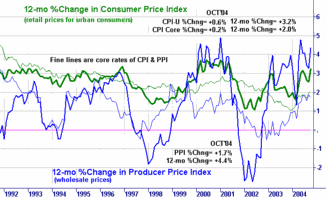NASDAQ 2,077.68 +.34%
Leading Sectors
Boxmakers +2.21%
Transports +1.36%
Iron/Steel +1.31%
Lagging Sectors
Semis -.14%
Telecom -.17%
Biotech -.33%
Other
Crude Oil 48.60 -.59%
Natural Gas 6.79 -4.57%
Gold 448.50 +.43%
Base Metals 117.39 -.97%
U.S. Dollar 83.16 -.18%
10-Yr. T-note Yield 4.16% -.83%
VIX 13.21 -2.15%
Put/Call .71 -11.25%
NYSE Arms 1.15 -8.0%
Market Movers
KKD -17.6% after missing 3Q estimates and BB&T downgrade to Underweight.
SIRI +11.0% on continued optimism over the hiring of Karmazin.
AAPL +10.3% after Piper Jaffray reiterated Outperform and raised target to $100 from $52.
AGIX -13.4% after the company said an experimental drug was ineffective in one of two tests.
TASR -6.8% on continued selling from worries over insider selling.
FRX -7.4% after BofA downgrade to Sell.
PCSA +22.4% after Alamosa Holdings offered to buy it for about $354.3 million in stock.
PTZ +15.2% after the company said it's considering a possible sale.
BTU +6.6% on continued optimism over demand for coal.
INCX +12.6% after announcing that it has licensed its Local Direct search and advertising platform to Internet Yellow Pages provider, MyePages.
ADBL +11.7% on Piper Jaffray upgrade to Outperform, target $35.
ACI +5.6% on continuing optimism over coal demand.
Economic Data
None of note.
Recommendations
-Goldman Sachs reiterated Outperform on AA and AMGN.
-Banc of America downgraded FRX to Sell, target $34.
-Citi SmithBarney reiterated Sell on SUP and GNTX. Citi reiterated Buy on BWA. Citi reiterated Buy on AIQ, target $12. Citi reiterated Sell on WOOF, target $18. Citi removed PBG, WMT and MDT from Recommended List and added JNJ, VIAB, L, DE and MAY. Citi reiterated Buy on DIS, target $31. Citi reiterated Sell on MYG, target $14. Citi reiterated Buy on UNM, target $20. Citi reiterated Attractive view of Oil Service sector, favorites remain RIG, DO, SII, SLB and BHI. Citi upgraded Semi/Semi Equipment sectors to Market Weight and raised Media sector to Overweight.
-UBS reiterated Reduce on GOOG.
-JP Morgan raised FO to Overweight.
-Deutsche Bank raised GCI to Buy, target $90. Deutsche rated HURN Buy, target $24.
Mid-day News
U.S. stocks are modestly higher mid-day on strength in computer and cyclical shares. Growth in U.S. employers' health-care costs rose 7.5% in 2004, the smallest such rise in five years, and may slow next year, the Wall Street Journal reported. U.S. local-telephone companies and satellite tv companies have been able to win customers from cable with packages combining phone and satellite service, the NY Times reported. NY's port is reversing a decades-long decline as Chinese imports increase, with container traffic up 65% from 1998, the NY Times reported. AOL will focus on increasing Internet ad revenue by promoting its free AOL.com Web site instead of primarily trying to build a subscriber base, the NY Times reported. EBay has begun using a direct-mail catalog to lure new customers to its Web site, hoping to duplicate the success of retailers such as Ice.com, which sells jewelry on the Internet, the NY Times reported. Advertising companies are expected to account for about $5.2 trillion, or 20%, of the U.S. economy in 2005, the Wall Street Journal reported. PIMCO last week sold some of its German government debt and bought U.S. Treasuries, Barron's reported. The third quarter's average one-way U.S. business airfare of $217, which is the lowest in five years of quarterly tracking, is also 11% less than the average fare for 2003, USA Today reported. Eastman Kodak shipped 990,000 consumer digital cameras in the third quarter, only 10,000 fewer than Sony, the U.S. market leader, the AP reported. California Democratic lawmakers plan to reintroduce bills to legalize same-sex marriages and allow illegal immigrants to get drivers' licenses when the legislative session begins Dec. 6, the San Jose Mercury News reported. Pfizer's Liptor, Merck's Zocor and Bristol-Myers' Pravachol carry low risk of a deadly side effect that led to the withdrawal of Bayer's Baycol, a FDA study found. The pentagon will open to new bidders a contract to provide aerial-refueling tankers to the U.S. Air Force after Congress withdrew an earlier proposal worth $23 billion to Boeing, Bloomberg reported.
Bottom Line: The Portfolio is slightly higher mid-day on gains in my steel, wireless and internet longs. I added some new security, internet, semi and networking longs this morning, bringing the Portfolio's market exposure to 125% net long. I added to my long TASR position and I am using a stop-loss of $48.15 on my new shares. The tone of the market has improved substantially from the open and I now feel the recent correction has run its course. I expect U.S. stocks to rise into the close on short-covering, bargain hunting and optimism over future U.S. economic growth.
